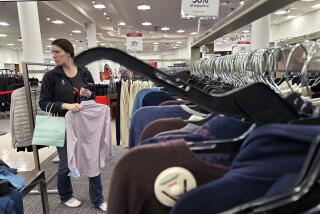GNP Growth Estimate Put at 2.2%; Drought a Factor
WASHINGTON — The U.S. economy, expanding at near-boom rates for the past four quarters, slowed to an annual growth rate of 2.2% last summer, held down by the drought, a rare drop in defense spending, the first downturn in net exports in a year and lower expansion of business investment, the government said Wednesday.
The Commerce Department’s preliminary report on growth in the July-September quarter estimated that the severe drought of early summer knocked 0.6 of a percentage point off the quarter’s annual growth rate, compared to a 0.9-point reduction in the second quarter and a projected 1.25 points in the October-December quarter.
Inflation-adjusted growth in the non-farm economy in the third quarter ran at an annual rate of 2.8%, compared to a pace of 3.9% in the second quarter--3%, counting drought effects--and 3.4% in the pre-drought January-March quarter.
That estimate, Undersecretary of Commerce Robert Ortner said, “indicates that we are on a moderate growth track of about 3%,” which should ease “concerns that the economy may be overheating.”
Ortner pointed out in a statement that the Commerce Department’s key estimate of inflation, based on price changes of actual expenditures during the quarter, rose at an annual rate of 4.9%, compared to 5% in the second quarter, a result in part distorted by the drought.
“Without the jump in farm and food prices,” he added, “the rate would have been 3.6%.”
Private analysts for the most part agreed, concluding on the whole that the economy still showed basic signs of strength on the eve of the sixth anniversary of the current expansion, even while inflation is clearly edging higher.
“If you look behind the headlines, there were signs of strength,” said Lynn Reaser of First Interstate Bancorp in Los Angeles. “Consumer spending was again strong. The reduction in net exports was mostly caused by a surge in imports, which means the economy had strength in the period. I see the main dampening forces as the cutback in defense purchases, the drought and the import surge.”
During the quarter, federal government spending--particularly for defense--declined at an annual rate of $2.7 billion in 1982 dollars, and defense purchases fell at an annual rate of 10.1%.
In addition, the Commerce Department report said net exports declined at an annual rate of $2.3 billion in inflation-adjusted 1982 dollars, compared to double-digit increases in the last two quarters and a $4.7-billion increase in the final quarter of 1987.
But exports of goods and services continued to expand, extending a trend that began in 1986 when the trade deficit began its longer-term improvement.
Exports grew by $10.1 billion in real terms, or 8.4%, after a 9.1% improvement in the spring quarter and a huge 25.7% improvement last winter. But imports expanded $12.4 billion, or 8.7%, after a 3.7% decline in the April-June quarter.
Investment Slower
“The government spending part is odd,” said Giulio Martini of the Sanford Bernstein & Co. investment firm in New York. “No one believes that’s really happening. And the improvement in trade, particularly merchandise trade, was extraordinarily rapid in the first and second quarters, so this slowdown probably doesn’t indicate that the trade turnaround is over.”
The other main engine of economic growth this year has been an explosion in business investment, and that continued in the third quarter, although at a much slower pace. Total business investment increased $5.5 billion to an annual rate of $495.7 billion, for a 4.5% annual rate of increase, compared to a 15% expansion rate last spring.
Personal income increased at an annual rate of $63.6 billion in 1982 dollars, compared to $71 billion in the second quarter. But Americans had more to spend, because personal tax payments fell $13.9 billion, compared to a $25.2-billion increase in the second quarter, as tax refunds during the summer offset tax payments in the spring.
More to Read
Sign up for Essential California
The most important California stories and recommendations in your inbox every morning.
You may occasionally receive promotional content from the Los Angeles Times.










